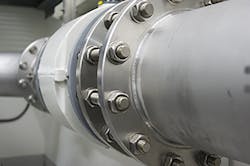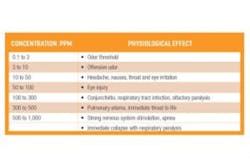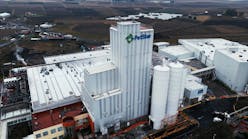Wastewater systems have long been subject odor and corrosion. The wastewater odor is the driving force behind implementing controls for these systems. Corrosion, however, has the greatest potential for environmental, systemic and economic harm. This damage can be in the form of burst pipes and other equipment failures. Failures of this type require equipment repair and replacement, and they have the potential to expose the environment to releases of hazardous waste that may be difficult, if not impossible, to contain or recover.
Corrosion caused by H2S
A major contributor to odor and corrosion in industrial systems is hydrogen sulfide (H2S) and its associated compounds. Some industrial wastewater contains sulfur compounds, which provide the molecular basis for the generation of H2S. H2S arises from the combination of anaerobic conditions and the presence of sulfites and sulfates with the slime layer – colonies of microorganisms present on the inner walls of all collection systems. Sulfate reducing bacteria (SRB) will use these compounds in the absence of free oxygen (O2) for metabolism. They do not use the sulfur component, and it is available to react with water, specifically free protons (H+), resulting in the generation of H2S.
Following its generation, H2S can be released into the atmosphere and find its way to receptors through junctions of the atmosphere and collection system, at which point it is an odor concern. H2S is a colorless gas that has a characteristic rotten egg odor, is highly toxic and is corrosive to certain metals. It is heavier than air, meaning it can accumulate in wells, manholes and other similar locations with little ventilation. Its effects on humans, at varying concentrations relative to ambient air, are shown in Table 1. Sulfuric acid is also a byproduct of anaerobic SRB – one of the primary causes of corrosion in collections systems.
Table 1. H2S health effects at different concentrations
H2S becomes a corrosion issue when it contacts moist concrete or steel, among other metals, in the presence of oxygen, even at very low gaseous concentrations. Conditions such as these are common in the headspace of some pipes and other areas where the collection system has easy access to atmospheric oxygen. SRB in these areas convert the H2S into sulfuric acid, which then begins a destructive reaction with the infrastructure.
Historically, control of odor and corrosion has been implemented through either vapor phase techniques, where the headspace of a system is treated, or liquid phase techniques, where treatments target the liquid flow. Vapor phase treatments like scrubbers do not provide corrosion control. Some of the liquid phase techniques offer corrosion control.
The most common method of inducing liquid phase treatment, or directly treating the wastewater inside the collection system, has been by dosing chemicals into the system. A constant and continuous dose of chemical is fed from a large reservoir with a small pump into the collection system, typically at a manhole or pump station. These chemicals are meant to react with the odor-causing compounds present in the wastewater or cease their formation and/or release from solution.
Conventional control options
The conventional classes of reactions used to control H2S are:
- Oxidation – Chemical oxidation of H2S is accomplished through the use of a compound with a high oxidation potential, called an oxidant. Liquid products such as hydrogen peroxide, sodium hypochlorite (bleach), paracetic acid or gaseous ozone that is infused into the process water.
- Sulfide scavengers – Also known as iron salts, these chemicals interact with H2S and sequester, or scavenge, the sulfur into a relatively insoluble form, such as ferric chloride and ferrous chloride, can be used to remove sulfur from the cycle entirely.
- pH adjustment – Because of the way that its ions dissociate in the aqueous phase, the release of H2S from wastewater will not occur if the pH is at 9 or above. H2S remains soluble in the wastewater until the pH is lower than 9.0 – usually at the headworks of the wastewater treatment system.
Alternate oxygen source or sulfate substitute
In an anaerobic environment, the microbiology in a collection system will use oxygen from a nitrate (NO3) molecule more readily than from a sulfate (SO4). As a result, benign nitrogen is released rather than H2S. Chemicals like calcium or sodium nitrate are commercially available for this purpose. They can be expensive, though, and they feed and grow the SRB layer, potentially requiring a higher volume for treatment over time.
Upon cessation of treatment, the amount of H2S can be even worse than before. Excess wet well build-up requires increased clean-out cycles because waxes added to stabilize the nitrate molecules can be encountered downstream in the collection system. In addition, emerging federal and state regulations are beginning to include nitrate concentrations on discharge limitations.
Real-time, active monitoring of wastewater H2S levels is seldom carried out, so enough chemical to control peak H2S values is typically added constantly. By treating for peak values with chemicals such as these, excess nitrate will likely be present and actively added to the wastewater, requiring additional denitrification processes or fines, both of which can be very expensive.
An issue with all chemicals is that, to introduce them to a collection system, a bulk quantity must be stored nearby. To ensure that chemicals are always available for treatment, continued deliveries to the bulk storage tank must be made. To avoid adverse effects to the environment, engineered controls, such as secondary containment and leak monitoring, must be designed, implemented and maintained.
Ideally, a successful treatment for wastewater odor and corrosion would:
- End sulfide production
- Quickly eliminate sulfides present
- Bring about no additional hazard to life or the environment
- Not harm the collection system
- Create no additional downstream challenges
In addition, the treatment solution must be cost effective. One answer is introducing ozone and oxygen into wastewater systems to control odor and corrosion.
Ozone has long been used in water treatment, dating back to at least the late 19th century, primarily for the disinfection and polishing of drinking water.4 In Europe, ozone treatment of water is a common process.5 Ozone’s environmental sustainability and relative safety versus chemical systems have established it as a favored current and future technology. The controlled use of ozone as a treatment does not produce harmful byproducts that could contaminate or damage the environment or ecology.
Typically, the only byproducts from its reaction are O2 and inert oxides. In recent years, interest in ozone’s use to treat wastewater has led to the development of new and sustainable (green) technology for odor and corrosion control in wastewater collection systems.
Ozone is a special, naturally occurring form of atmospheric oxygen. Instead of two oxygen atoms it has three, represented by its chemical formula O3. This third oxygen atom makes it a highly reactive molecule with very high oxidation potential. In fact, it has the highest oxidation potential of any commercially available molecule and the fourth highest overall with an oxidation potential of 2.07 volts (V). Above it, in terms of oxidation potential, are atomic fluorine (F•, 2.87 V), the hydroxyl radical (•OH, 2.86 V) and atomic oxygen (O•, 2.42 V). Ozone can be generated by exciting an oxygen flow with sufficient electrical or optical energy. This will cause a certain amount of oxygen atoms to split and recombine with other O2 molecules nearby. This is represented in Equation 1. Under typical treatment conditions, using a relatively pure oxygen stream and a corona discharge chamber that uses a high-voltage electrical arc, this reaction can produce up to 9 to 12 percentage by weight (wt%) ozone,6 although typically output is in 1 to 9 wt% ozone.7 The remainder of the stream is left as oxygen. The concentration is limited to this range because of the reaction shown in Equation 2.
As ozone levels rise above this concentration, the destruction reaction (Equation 2) becomes more frequent, returning greater quantities to O2 and maintaining this equilibrium. This instability is also the reason that ozone cannot be stored and must be generated immediately before application.
Because of its extreme instability and high oxidation potential, ozone is powerful and indiscriminate in terms of reactivity with other chemical species. Ozone is an effective treatment for the destruction of volatile organic compounds; the removal of metals, total suspended solids and organic carbon; and significant reductions to chemical oxygen demand.
In freshwater, the half-life of ozone is typically 10 to 20 minutes, but in wastewater, ozone has been documented as being entirely consumed within 8.6 seconds.8 This is because of the extreme amount of potential reactants present in wastewater including H2S. The simple structure of H2S makes it an easy target for oxidation by ozone. In addition to its high oxidation potential, ozone’s unique structure tends to create free radicals, chemical species that have unbonded electrons making them highly reactive, especially in water. Not only is the benefit of ozone’s direct reaction with different chemical species realized, additional free radicals, which can be even more reactive than ozone, can form. Additionally, radicals tend to create additional radicals as they react, in what is termed a free radical chain reaction.
These additional reactions are indirect effects of ozone.5 With the source of ozone generation being ambient air, it is the ultimate sustainable and green chemical treatment. The current technology for producing ozone has benefitted from more than 45 years of ongoing development, resulting in cost-effective and robust operation. Using little more than an oxygen separator, a corona discharge chamber and some compressors and other electrical components, on-site ozone generation is relatively simple and safe. This is in sharp contrast to most other treatments that are currently commercially available.
Because of the way ozone is produced, oxygen is necessarily going to be part of the treatment gas cocktail when using ozone. This is beneficial because oxygen is also an oxidizer. With an oxidation potential of 1.23 V, oxygen reacts slower than ozone but is an excellent complement. Aside from its ability to assist in oxidation, its primary benefit is increasing the dissolved oxygen (DO) concentration of the wastewater. This encourages the growth of aerobic bacteria, which do not create compounds that are odorous, corrosive or otherwise harmful to collection systems. It also eliminates the ability of SRB to produce sulfides, either by removing the SRB entirely or promoting the growth of aerobic species that will oxidize any sulfides before they are able to enter the wastewater stream.3
Combined use of oxygen & ozone for treatment
In terms of a robust and green method for the treatment and prevention of odor and corrosion in collections systems, the combined forces of oxygen and ozone are at the top of the list. Oxygen is widely available, making up roughly 21 percent of the atmosphere, and as has already been seen, it is easily converted to ozone.
The generation and infusion of these two gases into wastewater systems has proven to be a clean, safe and cost-effective treatment. The first method of action is the destructive effects of ozone on H2S, quickly converting it to sulfites and sulfates on contact. In addition, ozone’s antimicrobial properties can help reduce the presence of SRB and other microorganism present on pipe walls. As a product of its reaction, oxygen is generated. This adds more power to the oxygen part of the treatment gas cocktail, which provides secondary treatment by increasing DO and allows for more complete use of the infused treatment gases.
Oxygen will also oxidize H2S, but at a much slower rate than ozone. Because of these indiscriminate and powerful oxidizing characteristics, the concern is sometimes raised regarding the possibility of ozone attacking the wastewater infrastructure itself. This is unlikely to occur in application, especially in wastewater where liquid phase infusion is implemented. This is due to the high ratio of liquid volume compared to pipe surface area per unit of pipe length and the extreme availability of reactants in the liquid portion.
Ozone has been widely used in industrial wastewater as a disinfectant for pathogen control and as a powerful oxidizer for the removal of harmful organic contaminants. For potable applications, ozone is used as a primary disinfectant for the removal of harmful bacteria and as an oxidizer for taste, color and odor removal.
References
- American Society of Civil Engineers, “ASCE’s Infrastructure Report Card,” ASCE, 2009, http://infrastructurereportcard.org.
- A. Matthews et al, “Control of Hydrogen Sulfide Buildup in Forcemains using Ozone and Oxygen,” Proceedings of the Water Environment Federation, WEFTEC 2010: Session 101 through Session 112, pp. 7591-7611(21), 2010.
- U.S. Environmental Protection Agency, “Odor and Corrosion Control in Sanitary Sewerage Systems and Treatment Plants,” Design Manual, EPA/625/1-85/018, Cincinnati, OH, 1985.
- Beltran, F.J., “Ozone Reaction Kinetics for Water and Wastewater Systems,” Lewis Publishers, 2004.
- Lenntech, “Water Disinfection Application Standards (For EU),” 1998, http://lenntech.com.
- Drago, J.A. et al, “Municipal Wastewater Ozonation Practice in the United States: Past, Present and Future,” Ozone: Science & Engineering, Volume 32, Issue 1, pp. 43-55, 2010.
- Plasma Technics, Inc., “Plasma Block Product Line, Product Detail,” 2011, http://plasmatechnics.com.
- Terry, P.A., “Application of Ozone and Oxygen to Reduce Chemical Oxygen Demand and Hydrogen Sulfide from a Recovered Paper Processing Plant,” International Journal of Chemical Engineering, Volume 2010, Article ID 250235, 2010.
Paul Turgeon is the CEO of Anue Water Technologies. He is a thought-leader in the water and wastewater industry, having purchased the industrial water business Chemtura Corp. in 2006 and creating BWA Water Additives. He grew this business as its president/COO and sold it in 2011 to the Berwind Corp. Since then, Turgeon has served on the boards of U.S. Water Services and Anue Water Technologies.
Larry Burbach is vice president of Sales for Anue Water Technologies. He is responsible for delivering effective ozone and oxygen technologies and equipment solutions for the control of odor; corrosion; and fat, oil and grease in North American and Australian municipal and industrial wastewater systems. Before joining Anue, Burbach served in director and vice president positions with Nalco, GE Betz, U.S. Filter and Siemens Water Technologies.
Tom Martin is the operations manager for Anue Water Technologies. He oversees the manufacturing and quality control of all systems and products, including purchasing and warehouse inventory. Martin also manages installation and field services for all capital systems from delivery to the site through commissioning. He is also Anue’s safety officer.
The authors welcome any questions or comments. They may be reached at [email protected] or 760-476-9090.






